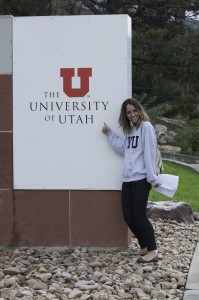
“You’re brave,” people said when I explained the story I was working on for The Universe.
Finding myself less absorbed in the outcome of a rivalry football game and more keen on understanding the relationships that revolve around it, I set out on an experiment. As a disclaimer, this experiment is not peer-reviewed, has a fairly small sample size and any academically trained mind would most likely not regard the following as fact. But in my defense, journalism is not as much an academic pursuit as it is information gathering and storytelling.
Since 1896, the Holy War — the rivalry between BYU and University of Utah football teams — has raged. Fans of both teams can most likely recount at least a few horror stories about the other team’s students or fan section at games. I wanted to discover, however, how the rivalry plays out off the field and in the hearts of fans in everyday terms.
The experiment was simple: I spent one day wearing a “Mighty Utah Student Section” (MUSS) t-shirt on the BYU campus and another day wearing a BYU sweatshirt on the U of U campus. On both campuses, I acted as a visitor, a newcomer or a transfer student who needed help.
The prospect of meandering onto the U of U campus donning Cougar paraphernalia frightened the BYU students who knew about my experiment. While I didn’t have a hypothesis going into this experiment, most students I talked to did: they expected hellfire and brutality.
But they were wrong.

On both campuses, students and faculty were polite and helpful. Not surprisingly, BYU students offered an eager smile at best, and at worst, a dirty look with an antagonistic comment within earshot. At both the U and BYU, those I approached were cordial and several even went out of their way to help me.
One BYU student offered me his number in case I got lost (I give him the benefit of the doubt, assuming he was genuinely trying to help me and not sizing up his next purchase at the meat market).
If anything, I observed that BYU students smiled more than U of U students. They wanted me to know they were friendly. Were they? Yes, but no more so than their rivals.
Several times on the U of U campus, I simply stood at a crossroads outside the library and looked lost. In the course of 30 minutes, three U of U students offered help without my asking. But when I did the same thing at BYU, I got less of a response.
My bravest move was heading into Legends Grill, a popular hangout for BYU athletes near the athletic facilities and locker rooms. I asked around to know what to order, and Adam Hogan, a senior cornerback, offered me some of his fries!
“Don’t let (people) give you crap about your shirt!” one BYU employee said. When I asked an MBA student where the Blue Line Deli was, he said, “I don’t know if they’ll serve you with that shirt!” A student on the U campus said, “You’re awfully brave to wear that shirt!”
Really? Snarky comments, that’s it? And we call this the “Holy War?” I suppose the fact that BYU and Utah students treat each other with respect despite the century-long rivalry might make you feel good about humanity, but it isn’t exactly newsworthy. Case cracked, people are nice — not the most shocking headline.
Does what I discovered violate loyalty? Can someone really say they loathe their rival if when they meet it head on, they are kind and compassionate? That’s not what makes a rivalry intense, said Mikaela Dufur, a BYU professor of sociology who specializes in sports sociology.
While rivalries stem from our human nature to categorize things, they thrive on scarcity, Dufur said.
“Scarcity of resources is a really fancy way of saying only one team can win,” Dufur said. “And when we’re competing for something that’s scarce, we default to our lesser selves a lot more quickly than if we’re competing for something that’s easy to have.”
So asking for directions in enemy territory won’t breed immediate violence, but talking trash at Saturday’s game will because you’ll be competing for a precious commodity: a victory.
Likewise, Dufur said one reason the BYU-Utah rivalry is so intense may be because in the end, we’re really not all that different.
“I do think that our student bodies are not all that terribly different if you look at it at a macro-level,” she said. “But the edges want to believe they’re very different. The rivalry is going to have meaning for them because they’re distinguishing themselves.”
Both campuses are home to about 30,000 students and are within 50 miles of each other. Both student bodies pull from populations who are trained to be polite, Dufur said.
Was I surprised that a senior on the BYU football team would offer a red-clad Ute fan his fries? Yes. But I shouldn’t have been.
So here’s some food for thought to take to the last Holy War football game you’ll see in three years: the fans you profess to hate may get under your skin at the game, but on every other day they are just like you. Though they’ll be wearing a different color on Saturday, on a day-to-day basis we’re all just trying to get to class on time, working for an A on a paper and hoping to get a date this weekend.




